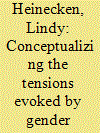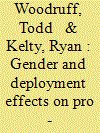| Srl | Item |
| 1 |
ID:
152317


|
|
|
|
|
| Summary/Abstract |
The South African military has adopted an assertive affirmative action campaign to ensure that women are represented across all ranks and branches. This has brought about new tensions in terms of gender integration, related to issues of equal opportunities and meritocracy as well as the accommodation of gender difference and alternative values. The argument is made that the management of gender integration from a gender-neutral perspective cannot bring about gender equality, as it obliges women to conform to and assimilate masculine traits. This affects women’s ability to function as equals, especially where feminine traits are not valued, where militarized masculinities are privileged and where women are othered in ways that contribute to their subordination. Under such conditions, it is exceedingly difficult for women to bring about a more androgynous military culture espoused by gender mainstreaming initiatives and necessary for the type of missions military personnel are engaged in today.
|
|
|
|
|
|
|
|
|
|
|
|
|
|
|
|
| 2 |
ID:
152321


|
|
|
|
|
| Summary/Abstract |
This study examines whether gender moderates the relationships between deployment and both organizational identification and pro-organizational behaviors. The broader context motivating this study is the U.S. military’s 2016 rescission of the ground combat exclusion, accomplishing full gender integration in the armed forces. Structural equation modeling is used to test for gender moderation effects. Results reveal deployment frequency, but not current deployment, has small effects on several pro-organizational behaviors. Results also show that gender does not moderate the effects of deployment frequency on soldiers’ perceptions of the organization or economic or social satisfaction. Gender does moderate the effects of deployment frequency on soldiers’ identification with the army. Additionally, while gender was not found to moderate the relationship between combat deployments and overall pro-organizational behaviors among soldiers, it does moderate the effect of deployments on one pro-organizational item: sacrificing behavior. Implications are discussed with an eye toward full gender inclusion in the U.S. military.
|
|
|
|
|
|
|
|
|
|
|
|
|
|
|
|
| 3 |
ID:
171012


|
|
|
|
|
| Summary/Abstract |
While women have been present on battlefields through history, their roles have expanded considerably in recent decades. The lifting of remaining restrictions fits into the pattern of expansion over time. Here, we focus on the Marine Corps infantry. We model the entry of women into infantry positions over time, but we also provide context for the current changes based on previous U.S. experience, and the experiences of other countries. Previous experiences opening closed occupations to women suggest that a variety of specific strategies are likely to be helpful to the Marines’ integration efforts. Both our cost model and previous experiences suggest that the proportion of women in the Marine Corps infantry is likely to grow very slowly; rates at which women complete training and remain in the Marine Corps will have a substantial impact on this growth. Mostly because growth is expected to be slow, the personnel-related costs of integration are predicted to be modest.
|
|
|
|
|
|
|
|
|
|
|
|
|
|
|
|
| 4 |
ID:
186343


|
|
|
|
|
| Summary/Abstract |
Current debates about bathrooms and bathroom policy contribute to a long history of how space shapes norms and expectations about privacy and gender equity in the workplace. The military serves as a significant site of discussion, particularly as the Department of Defense moves forward with efforts to integrate women into combat positions. Relying on an analysis of 27 focus groups with a total of 198 participants we collected from Special Operations in the U.S. Army, we examine bathrooms as a site where male soldiers contest and resist female integration. Using Sasson-Levy and Katz’s concept of institutional de-gendering and re-gendering, we argue that men’s resistance to gender-neutral toilets is an effort to re-gender Special Forces and maintain the hegemonic masculine culture that acutely defines it.
|
|
|
|
|
|
|
|
|
|
|
|
|
|
|
|